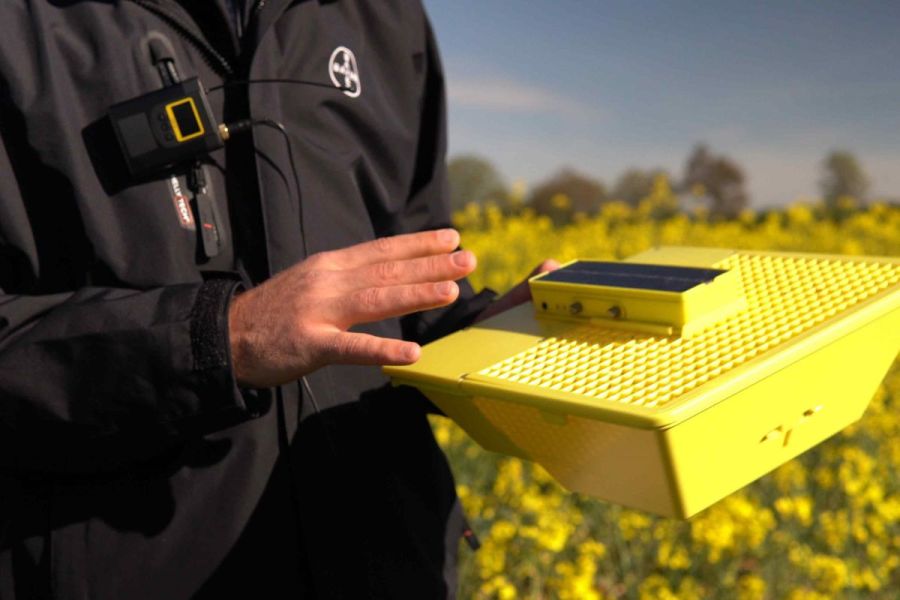As growers grapple for ways to stop pests decimating oilseed rape yields, a new digital monitoring tool based on AI could be key. CPM finds out more.
“AI is going to have a huge impact on agriculture.”
By Charlotte Cunningham
From self-parking cars to chatbots writing dissertations, artificial intelligence — AI — is everywhere you look in 2024.
But what exactly is AI, in its simplest form? The Oxford English Dictionary describes it quite neatly as the study and development of computer systems that can copy intelligent human behaviour — essentially, meaning it’s now possible to train computers to do things humans would otherwise have to.
Agriculture is one of the industries cashing in on the benefits of this, using AI to carry out a variety of functions such as monitoring livestock health, predicting crop performance and even bringing self-driving tractors to market.
Among the firms exploring the depths of the potential functionality of AI is Bayer. The company is no means a new player in the AI game, with its various tech including FieldView and crossbred breeding programmes all based on computer learning.
But ever-keen to expand its offer further, Bayer launched a brand-new AI-based pest monitoring tool at this year’s Cereals Event. Named MagicTrap, the tool is what Bayer is calling an automated, next generation digital yellow water trap, which provides continuously updated information on pest pressure in oilseed rape crops.
By automating this monitoring, Bayer says it hopes to make managing key OSR pests easier at a time when control options are limited, explains the firm’s Max Dafforn.
Looking at its journey to market, MagicTrap was developed by a team of European colleagues in Germany at the Crop Protection Innovation Laboratory (CPIL), explains Max. “This team are based on farm and are responsible for developing a range of new decision support tools.
“MagicScout was the first product to come out of the CPIL – as we call them – and was designed to help farmers and agronomists move from pen and paper to app-base recording and also incorporated AI technology to automatically identify different pests, weeds and diseases via images captured on the users’s smartphone.”
Max says MagicTrap was the next step in that evolution, to try and automate field observations even more so. “With standard yellow water traps proving impractical for many because of the time involved in checking and identifying their contents, MagicTrap provides a valuable extra layer of information on pest migration and pressure.”
So how exactly does it work? “MagicTrap is what’s called an Internet of Things connected device which allows growers and agronomists to remotely monitor pests in OSR in real time,” explains Max.
“Similarly to MagicScout, at the core of MagicTrap is sophisticated artificial intelligence image recognition which automatically identifies species captured by the on board, solar-powered high-resolution camera module attached to the trap.
“Once identified, the technology automatically sends this information to the MagicScout smartphone app, sending an alert to the grower if pest thresholds are reached.”
In terms of usability on farm, MagicTrap is solar powered with a seven-day battery back-up and a water reservoir topping-up trap levels for up to three weeks. A specially designed grid also prevents bees from entering the trap, he adds.
Though MagicTrap is able to identify several pests, including pollen beetle and weevil, continued pressure and limited solutions for cabbage stem flea beetle infestations makes the innovation particularly interesting for UK growers, believes Max. “Since the ban on neonicotinoids, cabbage stem flea beetle has become an increasing problem and is making growing OSR more of a challenge. Pyrethroids are now the only real chemical option when it comes to control.
“However, we know there’s now widespread resistance to these products and growers have to be very selective with their usage and timing of any applications to get the most from them.
“Therefore, the only way to effectively grow OSR is to adopt IPM strategies, and we feel that MagicTrap could really support this. The first step in any IPM approach is to monitor and measure and that’s exactly what MagicTrap is designed to do.”
In terms of how the tool can be used to support wider decision making on farm, Max says last year the traps were rolled out to growers and agronomists in trials and the feedback included everything from prompting more visual inspections of the field to tweaking insecticide programmes based on the pressures the trap revealed.
As well as this, Bayer has been testing the technology at its Callow site with the firm’s Gareth Bubb overseeing some of the trials. “We drilled a crop of OSR last September and put the trap in the field around the same time and monitored the crop from that point.”
Despite presumptions that the key migration period for flea beetle occurs late August, Gareth says something he was surprised to see in the trials was a peak of activity between 23-30 September.
“Interestingly, we’ve historically had a bit of a challenge with OSR establishment and it does make you wonder if this has previously been due to the timing of drilling versus when key infestations have actually occurred.”
Gareth says having access to this greater depth of information can prompt further management changes, all in a bid to get the most from OSR. “For example, if you’re going to switch to planting OSR in the ground in late September, you’re going to perhaps have to select a different variety – something that’s really vigorous, for example – but having this information can help better justify those decisions.
“It’s not a silver bullet, but it’s an important tool in the armoury to help growers make better decisions and hopefully get the most out of what’s already a very challenging crop.”
Max continues and says an area of use which he sees as having huge potential and value is when growers get the traps out in the field before the crop is drilled.
“We suggest putting the trap where you’ve had OSR the previous year and you have volunteers in the stubble – the flea beetle and other pests will be attracted to the volunteers, so it’ll give a really good indication of the pressure on that particular farm. This information can then be used to form the basis of drilling date decisions.
“Because of pest pressures, many farmers are now either going very early with their OSR drilling to try and get crops up and away to withstand any damage, or they’re going later after the main flea beetle migration window has passed. By having traps out in the field and continually monitoring this, it’ll allow growers to make a more informed decision about exactly when to drill.”
Looking to the future, work is already underway to expand the algorithms and ‘teach’ the computers to identify more pests in a wider range of crops, adds Max. “It’s continuously evolving and the more information we feed into these systems, the more accurate and expansive they’re going to get. In Germany, the system has now received almost one million images back from traps in the field.”
Another area Bayer is keen to explore as MagicTrap is rolled out is the value of the data from networks of local traps. “We believe that sharing of information between MagicTrap users could help to build an accurate picture of regional pest pressures and help these growers to strengthen their approach to tackling them.
“There’s no doubt in my mind that AI is going to have a huge impact on agriculture and tools like this are just the tip of an exciting iceberg,” concludes Max.
This article was taken from the latest issue of CPM. Read the article in full here.
For more articles like this, subscribe here.
Sign up for Crop Production Magazine’s FREE e-newsletter here.




